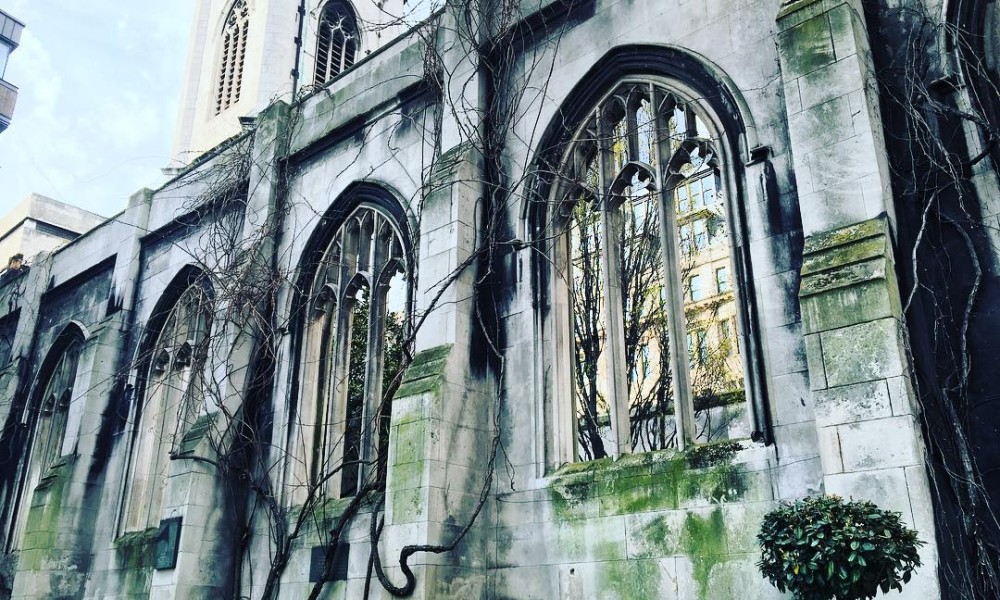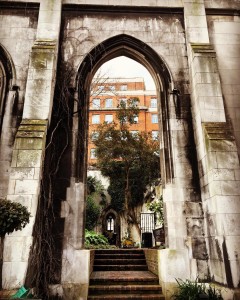
An Inspirational Walk
We all know the route we take every day to work; we know what corner to turn and what road to cross. We know what line to take and what change to make as we reluctantly descend the escalators where we cram onto a literal tube filled with people we don’t know yet hate even before we see their faces. However, maybe we didn’t know that our favourite pub to go for drinks with colleagues is actually the oldest pub in town. Or that particular shop sign we walk past has been hanging from that window since the early 18th century. I have been inspired by our festive season’s celebrations where we partook on a Christmas walk with archivist Janet Foster. We explored the area surrounding our office to divulge into the unknown facts of special places in London.
In mid-December last year the team at the Tavistock Institute all huddled together outside our office on Tabernacle Street to celebrate Christmas in an unusual way. We dove into the history of Bunhil fields, a former burial ground where poet William Blake lies along with writer John Bunyan. We then ventured down City road where we came across the drinking fountain in Finsbury Square, a memorial set up by the sons of Tom Smith for his wife in 1898. Rather fitting for our walk, Tom Smith was the inventor of the Christmas cracker where the ‘crack’ was inspired by logs burning on an open fire.
During our family Christmas lunch, which after our oven broke midway through roasting it could not appropriately be called lunch at all, we all picked up a cracker to pull with our table neighbours and even despite my dad’s inability to do this without cheating, I came away with a very charming compact mirror. After this traditional session, jokes told, hats on and all, I decided to delight all with the tale of how Tom Smith was inspired by the French Bon-Bon sweet wrappers, two twists either side of the sweet, which lead to the formation of the aesthetic of the cracker. Having learnt this from Janet as she told us about the story behind the drinking fountain in Finsbury Square I was able to share my knowledge with my family. An archivist has the opportunity to explore the very intricate details of a person, a place or an organisation that can prove to be very insightful and fascinating. Perhaps next year we’ll invite an actual archivist to lunch with us.
Our final stop was the Barbican which was designed by Chamberlin, Powell and Bon, officially opened in 1982 and a perfect example of the controversial brutalist design movement. Looking at it from afar, the three grey concrete towers that seem to guard the city of London (Latin word barbicana meaning fortress) can be described as intimidating, however upon further exploration of the site I found it to be a peaceful area to escape the impatient buzz of the city. The centre is very much focused around the arts and offers theatre, dance and film tickets to city dwellers and beyond and attracts visitors from around the globe. As a place I spent a lot of time at when I was younger I have a rather biased fondness of the site but it is hard not to be captivated by the intricate details that have gone behind the design. The gardens that grow herbs for people to pick and the waterside can be described as more than charming, a word you would perhaps not describe it as at a first glance.
I came away from our walk feeling intrigued, I have felt my interest in the city expand more and more over time, I love London and I feel very fortunate to have grown up here. There are many places I want to explore and to find the history of the hidden gems of the capital. As a city filled with very work driven people, it is hard to take a step back and explore where we really spend a lot of our time. 2016 is the first year I whole-heartedly made a resolution, to make time to discover new places.
It is coming up to the end of April and one of my most favourite places I have found is St Dunstan-in-the-East which is not far from Monument station. It is an old Anglo Saxon church ruin that was renovated into a public garden in 1971 after it was partially destroyed during the Blitz. It feels a peaceful and magical place, with ivy crawling up the beautifully archaic walls and appears as something you might find in a fairy tale or not unlike how imagined The Secret Garden would be. I am still on my journey, visiting Keats’ house in Hampstead and fondly taking out rowing boats on Hollow Ponds in Leytonstone. I look forward to more discovery within London but also beyond.
“At first people refuse to believe that a strange new thing can be done, then they begin to hope it can be done, then they see it can be done–then it is done and all the world wonders why it was not done centuries ago.”
― Frances Hodgson Burnett, The Secret Garden

.